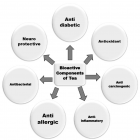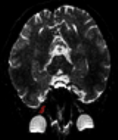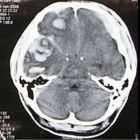Abstract
Review Article
Bioactive components of tea
Gargi Sena*, Moutusi Nath, Nilanjan Sarkar and Subhasis Maity
Published: 10 March, 2020 | Volume 4 - Issue 1 | Pages: 001-009
Tea (Black tea and Green tea) are one of the most widely consumed beverages in the world. However, with the increasing interest in the health properties of tea and a significant rise in scientific investigation, this review covers some of the recent findings on the health benefits of both green and black tea. The mechanisms of action of various black and green tea components have been presented. Green tea contains a unique set of catechins that responsible for its biological activity potentially relevant to the prevention of diseases. Although there has been much focus on the biological property of the major tea catechins, black tea offers major health benefits either due to the presence of the catechins in epimerized form or some other active components of both varieties of tea. Characteristics unrelated to the antioxidant properties of green and black tea might also be responsible for their therapeutic potential in preventing diseases. Synergistic effect of the tea constituents is increasingly recognized as being potentially important to the medicinal benefits of black and green tea. The studies indicate that tea has the potential of being a part of diet for healthy living.
Read Full Article HTML DOI: 10.29328/journal.afns.1001020 Cite this Article Read Full Article PDF
References
- Naghma K, Hasan M. Tea and Health: Studies in Humans Des. Curr Pharm. 2013; 19: 6141-6147. PubMed: https://www.ncbi.nlm.nih.gov/pubmed/23448443
- Koushik B, Rajeev KS, Baishakhi D, Bijoy CG, Prakash K, et al. Chemometrics Based Extraction of Polyphenolics from Fresh Tea Leaves and Processed Tea Showing In- Silico-ocking and Antioxidative Theronostic Dietary Adjuvant in Alzheimer. Indo Global Journal of Pharmaceutical Sciences. 2015.
- Lee MJ, Maliakal P, Chen L, Meng X, Bondoc FY, et al. Pharmacokinetics of tea catechins after ingestion of green tea and (-)-epigallocatechin-3-gallate by humans: formation of different metabolites and individual variability. Cancer Epidemiol Biomarkers Prev. 2002; 11: 1025-1032. PubMed: https://www.ncbi.nlm.nih.gov/pubmed/12376503
- Over C, Dora MB, Norma SK, Camillo R, Per-OB, et al. The unique cytoarchitecture of human pancreatic islets has implications for islet cell function. Proc Natl Acad Sci USA. 2006; 103: 2334-2339. PubMed: https://www.ncbi.nlm.nih.gov/pubmed/16461897
- Mukhtar H, Ahmad N. Green tea in chemoprevention of cancer. Toxicol Sci. 1999; 5: 111-117. PubMed: https://www.ncbi.nlm.nih.gov/pubmed/10630599
- Bushman JL. Green tea and cancer in humans: a review of the literature, Nutr Cancer. 1998; 31: 151-159. PubMed: https://www.ncbi.nlm.nih.gov/pubmed/9795966
- Susie L, Yung HK, Richard AH. Green tea: Biochemical and biological basis for health benefits. Vitam Horm. 2001; 62: 1-94. PubMed: https://www.ncbi.nlm.nih.gov/pubmed/11345896
- Mikhail AB, Nina IS. The biochemistry and technology of tea manufacture. Crit Rev Food Sci Nutr. 1998; 12: 303-370. PubMed: https://www.ncbi.nlm.nih.gov/pubmed/6996921
- Lenore K, Karen GCW, Susan S, Frans JK. Tea and cancer prevention: An evaluation of the epidemiologic literature. Nutr Cancer. 2009; 27: 1-13. PubMed: https://www.ncbi.nlm.nih.gov/pubmed/8970175
- Kuroda Y, Hara Y. Antimutagenic and anticarcinogenic activity of tea polyphenols. Mutat Res. 1999; 436: 69-97. PubMed: https://www.ncbi.nlm.nih.gov/pubmed/9878691
- Middleton E Jr, Kandaswami C, Theoharides TC. The effects of plant flavonoids on mammalian cells: implications for inflammation, heart disease, and cancer. Pharmacol Rev. 2000; 52: 673-751. PubMed: https://www.ncbi.nlm.nih.gov/pubmed/11121513
- Mukhtar H, Ahmad N. Tea polyphenols: prevention of cancer and optimizing health. Am J Clin Nutr. 2000; 71: 673-751. PubMed: https://www.ncbi.nlm.nih.gov/pubmed/10837321
- Nijveldt RJ, van Nood E, van Hoorn DE, Boelens PG, van Norren K, et al. Flavonoids: a review of probable mechanisms of action and potential applications. Am J Clin Nutr. 2001; 74: 418-425. PubMed: https://www.ncbi.nlm.nih.gov/pubmed/11566638
- Riemersma RA, Rice ECA, Tyrrell RM, Clifford MN, Lean MEJ. Tea flavonoids and cardiovascular health. QJM. 2001; 94: 277-282. PubMed: https://www.ncbi.nlm.nih.gov/pubmed/11353103
- Stoner GD, Mukhtar H. Polyphenols as cancer chemopreventive agents. J Cell Biochem Suppl. 995; 22: 169-180. PubMed: https://www.ncbi.nlm.nih.gov/pubmed/8538195
- Huafu W, Gordon J, Provan, KH. Tea flavonoids: their functions, utilization and analysis. Trends Food Sci Technol. 2000; 11: 152-160.
- John HW. Second International Scientific Symposium on Tea and Human Health. Proc Soc Exp Biol Med. 1999; 220: 193-194. PubMed: https://www.ncbi.nlm.nih.gov/pubmed/10202385
- Douglas AB, Sheila AW, Liesbeth CM. The chemistry of tea flavonoids. 2009; 693-704.
- Chung SY. Inhibition of carcinogenesis by tea. 1997; 389: 134-135.
- Yang CS, Landau JM. Effects of tea consumption on nutrition and health. J Nutr. 2000; 2: 2409-2412. PubMed: https://www.ncbi.nlm.nih.gov/pubmed/11015465
- Hung YL. The Structural Characteristics of Green Tea Polyphenols on Lipopolysaccharide-Stimulated RAW Cells. J Nutri Biol. 2018; 2: 151-157.
- Vauzour D, Vafeiadou K, Rodriguez-Mateos A, Rendeiro C, Spencer JPE. The neuroprotective potential of flavonoids: a multiplicity of effects. Genes Nutr. 2008; 3: 115-126. PubMed: https://www.ncbi.nlm.nih.gov/pubmed/18937002
- Pandey KB, Rizvi SI. Plant Polyphenols as Dietary Antioxidants in Human Health and Disease. Oxid Med Cell Longev. 2009; 2: 270-278. PubMed: https://www.ncbi.nlm.nih.gov/pubmed/20716914
- Fujiki H. Two stages of cancer prevention with green tea. J Cancer Res Clin Oncol. 1999; 125: 589-597. PubMed: https://www.ncbi.nlm.nih.gov/pubmed/10541965
- Peterson J. Major flavonoids in dry tea. J Food Comp Anal. 2005; 18: 487-501.
- Michael GL, Hertog PC, Hollman B, Van de P, Agric J. Content of potentially anticarcinogenic flavonoids of tea infusions, wines, and fruit juices. Food Chem. 1993; 41-48.
- Krishnan R, Maru G. Isolation and analyses of polymeric polyphenol fractions from Black tea. Food Chem. 2006; 331-340.
- Leenen R, Roodenburg AJC, Tijburg LBM, Wiseman SA. A single dose of tea with or without milk increases plasma antioxidant activity in humans. Eur J Clin Nutr. 2000; 54: 87-92. PubMed: https://www.ncbi.nlm.nih.gov/pubmed/10694777
- Jin ZX, Sai YVY, Qi C, Yu H, Zhen YC. Comparison of antioxidant activity and bioavailability of tea epicatechins with their epimers. Br J Nutr. 2004; 91: 873- 881. PubMed: https://www.ncbi.nlm.nih.gov/pubmed/15182391
- Alexander Y, Yakov Y, Boris N. Determination of Antioxidant Activity in Tea Extracts, and Their total antioxidant content. Am J Biom Sci. 2011.
- Ya LS, Lai KL, Yu H, Zhen YC. Stability of tea theaflavins and catechins. Food Chem. 2003; 83: 189-195.
- Jou AL, Wei CY, Ju YH. An assessment of genetic relationships in cultivated tea clones and native wild tea in Taiwan using RAPD and ISSR markers. Bot Bull. 2000; 93-100.
- Łuczaj W, Skrzydlewska E. Antioxidative properties of black tea. Prev Med. 2005; 910-918. PubMed: https://www.ncbi.nlm.nih.gov/pubmed/15850895
- Sheila AW, Douglas AB, Balz F. Antioxidants in tea: Critical Reviews in Food Science and Nutrition. Tea and Health. 1997; 37.
- Vasundhara S, Honnaiah VKL, Jagan MR. Influence of milk and sugar on antioxidant potential of black tea. Research International. 2008; 124-129.
- Eric WCC, Eu YS, Pei PT, Yon PL. Antioxidant and antibacterial properties of green, black, and herbal teas of Camellia sinensis. Pharmacognosy Res.2011; 3: 266-272. PubMed: https://www.ncbi.nlm.nih.gov/pubmed/22224051
- Maki H, Katsumi Y. Liquid Crystalline Behavior and Optical Properties of Poly (2,5-dinonyloxy-p-phenylenevinylene). Japanese Journal of Applied Physics. 1994; 33.
- Leung LK, Su Y, Chen R, Zhang Z, Huang Y, et al. Theaflavins in black tea and catechins in green tea are equally effective antioxidants. J Nutr. 2001; 131: 2248-2251. PubMed: https://www.ncbi.nlm.nih.gov/pubmed/11533262
- Hong L, Xiaofeng M, Chuan L, Shengmin S, Christopher P, et al. Glucuronides of Tea Catechins: Enzymology of Biosynthesis and Biological Activities. Drug Metab Dispos. 2003; 31: 452461. PubMed: https://www.ncbi.nlm.nih.gov/pubmed/12642472
- Jin WJ, Chih YL, Shiming LS, Sang CYW, Ang TM. et al. Agric: Stability of Black Tea Polyphenol, Theaflavin, and Identification of Theanaphthoquinone as Its Major Radical Reaction Product. Food Chem. 2005; 53; 6146-6150. PubMed: https://www.ncbi.nlm.nih.gov/pubmed/16029009
- Slobodan VJ, Micheal GS. Antioxidants in Nutrition. Ann New York Acad Sci. 2000; 899: 326-334.
- Kyoji Y, Isao T, Mitsuaki S, Itaro O, Yukihiko H, et al. Effects of long-term dietary supplement of tea polyphenols on lipid peroxide levels in rats. Age. 1994; 17: 79-85.
- Xinling Y, Jun F, Zhengguo LL, Yu WL, Walter JF. Tea Classification Based on Artificial Olfaction Using Bionic Olfactory Neural Network. Int Sym Neur Net. 2006; 343-348.
- Agarwal R, Mukhtar H. Cancer chemoprevention by polyphenols in green tea and artichoke. Adv Exp Med Biol. 1996; 401: 3550. PubMed: https://www.ncbi.nlm.nih.gov/pubmed/8886125
- Samir M, Tanmay SN, Koushik B, Adinpunya M, GhoshBC, et al. Protective effect of tea against copper (Cu) toxicity in erythrocyte. International Journal of Tea Science. 2013; 12-25.
- Xin M, Yuan YW, Xiao M, You YT. Antagonism of phenanthrene cytotoxicity for human embryo lung fibroblast cell line HFL-I by green tea polyphenols. Environ Pollut. 2011; 159: 164-168. PubMed: https://www.ncbi.nlm.nih.gov/pubmed/20932619
- Miller NJ, Castelluccio C, Tijburg L, Rice EC. The antioxidant properties of theaflavins and their gallate esters--radical scavengers or metal chelators? FEBS Lett. 1996; 19: 40-44. PubMed: https://www.ncbi.nlm.nih.gov/pubmed/8769311
- Tetsuo O, Mari K, Keiko M, Osamu N. Elucidation of the Partial Structure of Polymeric Thearubigins from Black Tea by Chemical Degradation. 2014; 60: 2023-2027.
- James WD, Michael NC, Jacek O, Nikolai K. The chemistry of low molecular weight black tea polyphenols. Nat Prod Rep. 2010. 27: 417-462 PubMed: https://www.ncbi.nlm.nih.gov/pubmed/20179879
- Yudong Z, Xiaojun Y, Carlo C, Ravipudi VR, Shuihua W. Tea Category Identification Using a Novel Fractional Fourier Entropy and Jaya Algorithm. 2016; 18.
- Huimei C, Yangyang D, Yeyun L, Daxiang L, Chuanyi P, et al. Physiological and cellular responses to fluoride stree in tea (Camellia sinensis) leaves. Acta Physiologiae Plantrum. 2016; 38.
- Junhua L, Rafael RG, John S, Lei F. Habitual tea drinking modulates brain efficiency: evidence from brain connectivity evaluation. Aging. 2019; 11: 3876-3890. PubMed: https://www.ncbi.nlm.nih.gov/pubmed/31209186
- Bogdan C. Nitric oxide and the immune response. Nat Immunol. 2001; 907-916.
- Nitric oxide and inflammatory bowel diseases. Eur J Clin Inv. 2001.
- Anasuya S, Amar B. Black Tea Is a Powerful Chemopreventor of Reactive Oxygen and Nitrogen Species: Comparison with Its Individual Catechin Constituents and Green Tea. Biochem Biophys Res Commun. 2001; 284: 173-178. PubMed: https://www.ncbi.nlm.nih.gov/pubmed/11374887
- Kim ES, Liang YR, Jin QJ, Sun FJ, Lu YL, et al. Impact of heating on chemical compositions of green tea liquor. Food Chem. 2007; 103: 1263-1267.
- Ming X, Genie ED, Legarda S, Joseph L. Production of Vascular Endothelial Growth Factor by Murine Macrophages: Regulation by Hypoxia, Lactate, and the Inducible Nitric Oxide Synthase Pathway. Am J Pathol. 1998; 153: 587-598. PubMed: https://www.ncbi.nlm.nih.gov/pubmed/9708818
- Lin CM, Chen CS, Chen CT, Liang YC, Lin JK. Molecular modeling of flavonoids that inhibits xanthine oxidase. Biochem Biophys Res Commun. 2002; 294; 167-172. PubMed: https://www.ncbi.nlm.nih.gov/pubmed/12054758
- Alexandra BB. A Review of Quercetin: Chemistry, Antioxidant Properties, and Bioavailability. Journal of Young Investigators. 2009.
- Gargi S, Biswajit B. Black tea as a part of daily diet: A boon for healthy living. International journal of Tea Science. 2013; 9.
- David V. Biological Actions and Molecular Mechanisms Underpinning, Their Beneficial Effects. Oxid Med Cell Longev. 2012; 16. PubMed: https://www.ncbi.nlm.nih.gov/pubmed/22701758
- Trina K, Subhabrata D, Madhumita R, Siddiqi M, Bhattacharya RK. Induction of apoptosis in human leukemia cells by black tea and its polyphenol theaflavin. 2005; 230: 111-121. PubMed: https://www.ncbi.nlm.nih.gov/pubmed/16253767
- Sang S, Hou Z, Lambert JD, Yang CS. Redox properties of tea polyphenols and related biological activities. Antioxid Redox Signal. 2005; 7: 1704-1714. PubMed: https://www.ncbi.nlm.nih.gov/pubmed/16356131
- Shukla Y, Tanya P. Anticarcimogenic effect of black Tea on pulmonary tumors of Swiss Albino mice. Cancer Letters. 2002; 25: 137-141. PubMed: https://www.ncbi.nlm.nih.gov/pubmed/11804740
- Lahiry L, Mandal DP, Bhattacharyya A, Sa G, Das T. Cancer prevention by cancer regression and rejuvenation of host’s defense system; dual role of tea. Medicinal Properties of tea. 2005.
- Sarkar S, Sett P, Chowdhury T, Ganguly DK. Effect of black tea on teeth. J Indian Soc Pedod Prev Dent. 2000; 18: 139-140. PubMed: https://www.ncbi.nlm.nih.gov/pubmed/11601182
- Hamidreza A, Ahmad M, Shayan G, Hoomanshafaee, Keyvan S, et al. Review of The therapeutic effects of Camellia sinensis (green tea) on oral and periodontal health. J Medi Pla Res. 2011; 5: 5465-5469.
- Xu X, Zhou XD, Wu CD. Tea catechin epigallocatechin gallate inhibits Streptococcus mutans biofilm formation by suppressing gtf genes. Arch Oral Biol. 2012; 57: 678-683. PubMed: https://www.ncbi.nlm.nih.gov/pubmed/22169220
- Hattori M, Kusumoto IT, Namba T, Ishigami T, Hara Y. Effect of tea polyphenols on glucan synthesis by glucosyltransferase from Streptococcus mutans. Chem Pharm Bull. 1990; 38: 717-720. PubMed: https://www.ncbi.nlm.nih.gov/pubmed/2140716
- Yali J, Guanjun H, Yun H, Yan B, Lirong L, et al. Tea consumption and risk of Type 2 Diabetes: A Meta-Analysis of Cohort Studies. J Gen Intern Med. 2009; 24: 557-562. PubMed: https://www.ncbi.nlm.nih.gov/pubmed/19308337
- Ying Z, Lanting Z, Xiaoyu L, Jiadong G, Xin M, et al. Formation of (E)-nerolidol in tea (Camellia sinensis) leaves exposed to multiple stresses during tea manufacturing. Food Chem. 2017; 231: 78-86. PubMed: https://www.ncbi.nlm.nih.gov/pubmed/28450026
- Yoshino K, Yamazaki K, Sano M. Preventive effects of black tea theaflavins against mouse type IV allergy. J Sci Food Agric. 2010; 90: 1983-1987. PubMed: https://www.ncbi.nlm.nih.gov/pubmed/20597096
- Ding Y, Li C, Zhang Y, Ma P, Zhao T, et al. Quercetin as a Lyn kinase inhibitor inhibits IgE-mediated allergic conjunctivitis. Food Chem Toxicol. 2020. 135: 110924. PubMed: https://www.ncbi.nlm.nih.gov/pubmed/31672514
- Young DJ, Lee ME. Inhibition of tumour invasion and angiogenesis by epigallocatechin gallate (EGCG), a major component of green tea. Int J Exp Pathol. 2001; 82: 309-316. PubMed: https://www.ncbi.nlm.nih.gov/pubmed/11846837
- Anna RB, Simona La TM, Gioia B, Spiridione G, Vincenzo E, et al. (−)Epigallocatechin-3-gallate inhibits gelatinase activity of some bacterial isolates from ocular infection, and limits their invasion through gelatin. Biochim Biophys Acta. 2003; 1620: 273-281. PubMed: https://www.ncbi.nlm.nih.gov/pubmed/12595099
- Jun Y, Yunqiang Z, Yunqiang Z. Single-Junction Organic Solar Cell with over 15% Efficiency Using Fused-Ring Acceptor with Electron-Deficient Core. 2019; 3: 1140-1151.
- Bucolo C, Musumeci M, Maltese A, Drago F, Musumeci S. Effect of chitinase inhibitors on endotoxin-induced uveitis (EIU) in rabbits. Pharmacol Res. 2008; 57: 247-252. PubMed: https://www.ncbi.nlm.nih.gov/pubmed/18353673
- Amy RC, Siobhan A, Laura M, Nicola PH, Saurabh D, et al. Black tea polyphenols mimic insulin/insulin‐like growth factor‐1 signalling to the longevity factor FOXO1a. Aging Cell. 2008; 7: 69-77. PubMed: https://www.ncbi.nlm.nih.gov/pubmed/18005251
- Kati H, Riitta T, Isabel BP, Jenna P, Marjukka K, et al. Impact of Dietary Polyphenols on Carbohydrate Metabolism. Int J Mol Sci. 2010; 1365-1402. PubMed: https://www.ncbi.nlm.nih.gov/pubmed/20480025
- Ziyin Y, Eiji K, Tsuyoshi K, Toshimichi A, Tamaki F, et al. Characterisation of volatile and non-volatile metabolites in etiolated leaves of tea (Camellia sinensis) plants in the dark. Food Chemistry. 2012; 135: 2268-2276. PubMed: https://www.ncbi.nlm.nih.gov/pubmed/22980801
- Mostashari RT, Saghaei L, Fassihi A. Gp41 inhibitory activity prediction of theaflavin derivatives using ligand/structure-based virtual screening approaches. Comput Biol Chem. 2019; 78: 119-126. PubMed: https://www.ncbi.nlm.nih.gov/pubmed/30785021
- Astill C, Birch MR, Dacombe C, Humphrey PG, Martin PT. Factors affecting the caffeine and polyphenol contents of black and green tea infusions. J Agric Food Chem. 2001; 49: 5340-5347. PubMed: https://www.ncbi.nlm.nih.gov/pubmed/11714326
- Dong US, Young DJ, Kee OC, Min AC, Kee HL, et al. Effect of Drinking Green Tea on Age-Associated Accumulation of Maillard-Type Fluorescence and Carbonyl Groups in Rat Aortic and Skin Collagen. Arch Biochem Biophys. 2015; 3972: 424-429. PubMed: https://www.ncbi.nlm.nih.gov/pubmed/11795903
- Emma KK, Mike DA, Paul S.J, Peter JR, Caroline MP. How much theanine in a cup of tea? Effects of tea type and method of preparation. Food Chemistry. 2011; 125: 588594.
- Vuong QV, Golding JB, Nguyen M, Roach PD. Extraction and isolation of catechins from tea. J Sep Sci. 2010; 33: 3415-3428. PubMed: https://www.ncbi.nlm.nih.gov/pubmed/21049524
- Nobre AC, Rao A, Owen GN. L-theanine, a natural constituent in tea, and its effect on mental state. Asia Pac J ClinNutr. 2018; 167-168. PubMed: https://www.ncbi.nlm.nih.gov/pubmed/18296328
- Kakuda T. Neuroprotective effects of the green tea components theanine and catechins. Biol Pharm Bull. 2002; 1513-1518. PubMed: https://www.ncbi.nlm.nih.gov/pubmed/12499631
- Chattopadhyay P, Besra SE, Gomes A, Das M, Sur SM, et al. Anti- inflammatory activity of tea (Camellia sinensis) root extract. Life Sci. 2004; 74: 1839-1849. PubMed: https://www.ncbi.nlm.nih.gov/pubmed/14761665
- Shao PN, Ming YX. A review on the isolation and structure of tea polysaccharides and their bioactivities. Food Hydrocolloids. 2011; 2: 144-149.
- Deng Z, Tao B, Li X, He J, Chen Y. Effect of green tea and black tea on the metabolisms of mineral elements in old rats. Biol Trace Elem Res. 1998; 65: 75-86. PubMed: https://www.ncbi.nlm.nih.gov/pubmed/9877538
- Chen MJ, Jovanovic A, Taylor R. Utilizing the second meal effect in type 2 disbetes: practical use of a soya-yogurt snack. Diabetes Care. 2010; 2552-2554.
- Ariel B, Gerard D, Genevieve B, Dominique BG. Relationships between black tea consumption and key health indicators in the world: an ecological study. BMJ Open. 2012; 2. PubMed: https://www.ncbi.nlm.nih.gov/pubmed/23138107
- Takahashi M. Acute ingestion of catechin-rich green tea improves postprandial glucose status and increases serum thioredoxin concentrations in postmenopausal women. Br J Nutr. 2014; 112: 1542-1550. PubMed: https://www.ncbi.nlm.nih.gov/pubmed/25230741
- Shaoping N, Mingyong X, Zhihong F, Yiqun W, Aiping Y. Study on the purification and chemical compositions of tea. Carbohydrate Polymers. 2008; 71: 626-633.
- Karak T, Bhagat RM. Trace elements in tea leaves, made tea and tea infusion: a review. Food Res Int. 2010; 43: 2234-2252.
- Chow HH, Cai Y, Hakim IA, Crowell JA, Shahi F, et al. Pharmacokinetics and safety of green tea polyphenols after multiple-dose administration of epigallocatechin gallate and polyphenon E in healthy individuals. Clin Cancer Res. 2003; 9: 3312-3319. PubMed: https://www.ncbi.nlm.nih.gov/pubmed/12960117
- Lambert JD, Yang CS. Mechanisms of cancer prevention by tea constituents. J Nutr. 2003; 133: 3262S-3267S. PubMed: https://www.ncbi.nlm.nih.gov/pubmed/14519824
- Piskula MK, Terao J. Accumulation of (-)-epicatechin metabolites in rat plasma after oral administration and distribution of conjugation enzymes in rat tissues. J Nutr. 1998; 128: 1172-1178. PubMed: https://www.ncbi.nlm.nih.gov/pubmed/9649602
- Lee MJ, Wang ZY, Li H, Chen L, Sun Y, et al. Analysis of plasma and urinary tea polyphenols in human subjects. Cancer Epidemiol Biomarkers Prev. 1995; 4: 393-399. PubMed: https://www.ncbi.nlm.nih.gov/pubmed/7655336
- Kazuo O, Masayuki S, Natsuki M, Fumio N, Yukihiko H. Methylation of Tea Catechins by Rat Liver Homogenates. Biosci Biotechnol Biochem. 1999; 63: 430-432. PubMed: https://www.ncbi.nlm.nih.gov/pubmed/10192923
- Chow HH, Cai Y, Alberts DS, Hakim I, Dorr R, et al. Phase I pharmacokinetic study of tea polyphenols following single-dose administration of epigallocatechin gallate and polyphenon E. Cancer Epidemiol Biomarkers Prev. 2001; 10: 53-58. PubMed: https://www.ncbi.nlm.nih.gov/pubmed/11205489
- Chuan L, Mao JL, Shuqun S. Structural Identification of Two Metabolites of Catechins and Their Kinetics in Human Urine and Blood after Tea Ingestion. Chem Res Toxicol. 2002; 177-184. PubMed: https://www.ncbi.nlm.nih.gov/pubmed/10725114
- Huong TTP, Tsuyoshi Y, Bindu C.Structure-dependent interactions of polyphenols with a biomimetic membrane system. Biochimica Biophysica Acta. 2014; 1838: 2670-2677. PubMed: https://www.ncbi.nlm.nih.gov/pubmed/25016053
- Navindra P, Seeram SM, Henning Y, Niu R, Lee H, et al. Catechin and Caffeine Content of Green Tea Dietary Supplements and Correlation with Antioxidant Capacity. J Agric Food Chem. 2006; 1599-1603. PubMed: https://www.ncbi.nlm.nih.gov/pubmed/16506807
- Frei B, Higdon JV. Antioxidant activity of tea polyphenols in vivo: evidence from animal studies. J Nutr. 2003; 3275-3284. PubMed: https://www.ncbi.nlm.nih.gov/pubmed/14519826
- Lee MJ, Maliakal P, Chen L, Meng X, Bondoc FY, et al. Pharmacokinetics of tea catechins after ingestion of green tea and (-)-epigallocatechin-3-gallate by humans: formation of different metabolites and individual variability. Cancer Epidemiol Biomarkers Prev. 2002; 1025-1032. PubMed: https://www.ncbi.nlm.nih.gov/pubmed/12376503
- Susanne MH, Yantao N, Nicolas HL, Gail DT, Rosario RM, et al. Bioavailability and antioxidant activity of tea flavanols after consumption of green tea, black tea, or a green tea extract supplement. Am J Clin Nutr. 2004; 80: 1558-1564. PubMed: https://www.ncbi.nlm.nih.gov/pubmed/15585768
- Xiao YX, Cai NZ, Shi YC, Guo YT, Ren YG, et al. Effects and mechanisms of tea for the prevention and management of cancers: An updated review. Crit Rev Food Sci Nutr. 2019; 14: 1-13. PubMed: https://www.ncbi.nlm.nih.gov/pubmed/30869995
- Chaoling W. Draft genome sequence of Camellia sinensis var. sinensis provides insights into the evolution of the tea genome and tea quality. Proc Natl Acad Sci USA. 2018; E4151-E4158. PubMed: https://www.ncbi.nlm.nih.gov/pubmed/29678829
Figures:

Figure 1
Similar Articles
-
Changes in Serum Markers of Atherogenesis and Hematological Profile after the consumption of Quail eggsEkpenyong CE*,Patrick ES,Akpan KS. Changes in Serum Markers of Atherogenesis and Hematological Profile after the consumption of Quail eggs. . 2017 doi: 10.29328/journal.afns.1001001; 1: 001-011
-
Effect of storage period on the quality characteristics of two varieties of African Mango Seed Flour at ambient temperatureAdedeji TO*. Effect of storage period on the quality characteristics of two varieties of African Mango Seed Flour at ambient temperature. . 2017 doi: 10.29328/journal.afns.1001002; 1: 012-019
-
Do Fishes Hallucinate Human Folks?Dinesh R*,Sherry Abraham,Kathiresan K,Susitharan V,Jeyapavithran C,Paul Nathaniel T,Siva Ganesh P. Do Fishes Hallucinate Human Folks?. . 2017 doi: 10.29328/journal.afns.1001003; 1: 020-023
-
Effect of pre-treatments and drying methods on Moisture percentage of dried Tomato SlicesPokharkar KK*,Delvadia DV,Jadhav Parag B,Bhor PB. Effect of pre-treatments and drying methods on Moisture percentage of dried Tomato Slices. . 2017 doi: 10.29328/journal.afns.1001004; 1: 024-026
-
Effect of drying methods on the physicochemical properties and Fatty Acid composition of Moringa Seeds OilIbrahim TA*,Oloye DA,Omosuli SV. Effect of drying methods on the physicochemical properties and Fatty Acid composition of Moringa Seeds Oil . . 2017 doi: 10.29328/journal.afns.1001005; 1: 027-032
-
Anti-nutrient and mineral properties of Complementry Food produced from Malted Red Sorgum and Defatted Soybean Flour BlendOloye DA*,Agbaje RB,Olatunji CA,Olawale-Olakunle OE. Anti-nutrient and mineral properties of Complementry Food produced from Malted Red Sorgum and Defatted Soybean Flour Blend. . 2017 doi: 10.29328/journal.afns.1001006; 1: 033-038
-
Effect of Pre-Treatments and Drying Methods on the Chemical Quality and Microbial Density of Wild Edible Oyster MushroomIbrahim TA*,Adaramola-Ajibola KM,Adesuyi AT,Olanrewaju SO,Akinro EB. Effect of Pre-Treatments and Drying Methods on the Chemical Quality and Microbial Density of Wild Edible Oyster Mushroom. . 2017 doi: 10.29328/journal.afns.1001007; 1: 039-044
-
Assessment of Complementary Feeding Practice of infants and young children aged 6-23 months in Gode Town, Somali Regional State of EthiopiaYimer Mihretie*. Assessment of Complementary Feeding Practice of infants and young children aged 6-23 months in Gode Town, Somali Regional State of Ethiopia. . 2017 doi: 10.29328/journal.afns.1001008; 1: 045-057
-
Chemical composition and organoleptic properties of Cocoyam starch-wheat flour blend noodlesAdedeji Temileye Omotayo*. Chemical composition and organoleptic properties of Cocoyam starch-wheat flour blend noodles. . 2017 doi: 10.29328/journal.afns.1001009; 1: 058-062
-
Development and quality evaluation of Jam from Watermelon (Citrullus Lanatus) and Pawpaw (Carica Papaya) juiceAdedeji Temileye Omotayo*. Development and quality evaluation of Jam from Watermelon (Citrullus Lanatus) and Pawpaw (Carica Papaya) juice. . 2017 doi: 10.29328/journal.afns.1001010; 1: 063-071
Recently Viewed
-
Cystoid Macular Oedema Secondary to Bimatoprost in a Patient with Primary Open Angle GlaucomaKonstantinos Kyratzoglou*,Katie Morton. Cystoid Macular Oedema Secondary to Bimatoprost in a Patient with Primary Open Angle Glaucoma. Int J Clin Exp Ophthalmol. 2025: doi: 10.29328/journal.ijceo.1001059; 9: 001-003
-
Metastatic Brain Melanoma: A Rare Case with Review of LiteratureNeha Singh,Gaurav Raj,Akshay Kumar,Deepak Kumar Singh,Shivansh Dixit,Kaustubh Gupta*. Metastatic Brain Melanoma: A Rare Case with Review of Literature. J Radiol Oncol. 2025: doi: ; 9: 050-053
-
Depression as a civilization-deformed adaptation and defence mechanismBohdan Wasilewski*,Olha Yourtsenyuk,Eugene Egan. Depression as a civilization-deformed adaptation and defence mechanism. Insights Depress Anxiety. 2020: doi: 10.29328/journal.ida.1001013; 4: 008-011
-
Drinking-water Quality Assessment in Selective Schools from the Mount LebanonWalaa Diab, Mona Farhat, Marwa Rammal, Chaden Moussa Haidar*, Ali Yaacoub, Alaa Hamzeh. Drinking-water Quality Assessment in Selective Schools from the Mount Lebanon. Ann Civil Environ Eng. 2024: doi: 10.29328/journal.acee.1001061; 8: 018-024
-
Rapid Microbial Growth in Reusable Drinking Water BottlesQishan Liu*,Hongjun Liu. Rapid Microbial Growth in Reusable Drinking Water Bottles. Ann Civil Environ Eng. 2017: doi: 10.29328/journal.acee.1001007; 1: 055-062
Most Viewed
-
Evaluation of Biostimulants Based on Recovered Protein Hydrolysates from Animal By-products as Plant Growth EnhancersH Pérez-Aguilar*, M Lacruz-Asaro, F Arán-Ais. Evaluation of Biostimulants Based on Recovered Protein Hydrolysates from Animal By-products as Plant Growth Enhancers. J Plant Sci Phytopathol. 2023 doi: 10.29328/journal.jpsp.1001104; 7: 042-047
-
Sinonasal Myxoma Extending into the Orbit in a 4-Year Old: A Case PresentationJulian A Purrinos*, Ramzi Younis. Sinonasal Myxoma Extending into the Orbit in a 4-Year Old: A Case Presentation. Arch Case Rep. 2024 doi: 10.29328/journal.acr.1001099; 8: 075-077
-
Feasibility study of magnetic sensing for detecting single-neuron action potentialsDenis Tonini,Kai Wu,Renata Saha,Jian-Ping Wang*. Feasibility study of magnetic sensing for detecting single-neuron action potentials. Ann Biomed Sci Eng. 2022 doi: 10.29328/journal.abse.1001018; 6: 019-029
-
Pediatric Dysgerminoma: Unveiling a Rare Ovarian TumorFaten Limaiem*, Khalil Saffar, Ahmed Halouani. Pediatric Dysgerminoma: Unveiling a Rare Ovarian Tumor. Arch Case Rep. 2024 doi: 10.29328/journal.acr.1001087; 8: 010-013
-
Physical activity can change the physiological and psychological circumstances during COVID-19 pandemic: A narrative reviewKhashayar Maroufi*. Physical activity can change the physiological and psychological circumstances during COVID-19 pandemic: A narrative review. J Sports Med Ther. 2021 doi: 10.29328/journal.jsmt.1001051; 6: 001-007

HSPI: We're glad you're here. Please click "create a new Query" if you are a new visitor to our website and need further information from us.
If you are already a member of our network and need to keep track of any developments regarding a question you have already submitted, click "take me to my Query."

















































































































































